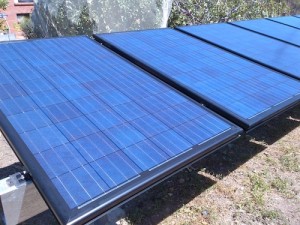Australian-Made Tindo Solar Panels to Take on Chinese Giants?
 In the same year that Australia saw its only home-grown solar PV manufacturer shutter its factory in Sydney due to increased competition from Chinese solar system component imports, another company popped up to claim the mantle of the ‘only Australian-made solar panel’. Tindo Solar began assembly of its panels in January 2012 and claims that it can compete even in the current ultra-competitive market by providing premium panels at reasonable prices — with a ‘Made in Australia’ sticker.
In the same year that Australia saw its only home-grown solar PV manufacturer shutter its factory in Sydney due to increased competition from Chinese solar system component imports, another company popped up to claim the mantle of the ‘only Australian-made solar panel’. Tindo Solar began assembly of its panels in January 2012 and claims that it can compete even in the current ultra-competitive market by providing premium panels at reasonable prices — with a ‘Made in Australia’ sticker.2011, although a banner year for global solar PV installations, was a rough one for many solar power manufacturers. Multiple bankruptcies of American solar manufacturers (most notably Solyndra), and slimming profit margins among the survivors, led to accusations of unfair Chinese government support for its own solar panel makers and a trade row whose final repercussions are as of yet unclear, but which may result in US import tariffs on Chinese panels. The fact that the Chinese government has decided to up solar PV production targets in the face of predictions of a sort of Chinese solar industry apocalypse does not bode well for many of the non-Chinese industry players.
Tindo solar panels popped up in the media at the end of 2011, announcing that it would begin production of panels in January 2012. The news of Tindo’s emergence arrived not long after the only other Australian solar panel manufacturer stopped making panels at its Sydney facility. That company — Silex Solar — closed up shop amid competitive pressure from Chinese imports and the outcry that the New South Wales conservative government had left it (and the state’s solar industry in general) out to dry by replacing the state’s feed-in tariff with nothing. Given all this history and the resulting solar environment, the news of Tindo entering the market has come as a surprise to many.
Products with a ‘Made in Australia’ label usually carry with them a premium price tag, and Tindo is no exception. The company seems keen to capitalise on the national trend to want to ‘Buy Australian’. The name of the company and its products couldn’t get much more home-grown: ‘Tindo’ is the Adelaide plains’ Aboriginal group’s native word for ‘Sun’, and the name of its first panel line — ‘Karra’ — means ‘sky’ or ‘heaven’.
Just a few months before ceasing production of panels, Silex Solar announced that it would stop making its own silicon cells, instead opting to outsource its production to an unnamed ‘strategic partner’, widely believed to be a Chinese manufacturer. Silex abandoned this point of difference, with some saying that it had compromised its key selling point in the Australian market. For Silex, in the end, ‘Made in Australia’ came to mean ‘Assembled in Australia’.
Interestingly, the same could be said about Tindo, which sources its components from overseas and puts them together at its highly automated factory in Adelaide, South Australia. However, unlike Silex, whose panels were not particularly technologically noteworthy, Tindo panels feature module-level Enecsys DC-AC micro-inverters, making central system inverters unnecessary. Other panel components have been selected for their quality and the reputation of their manufacturers — silicon cells come from German manufacturer Q-Cells, Bridgestone makes the encapsulant, and DuPont makes the backsheets. The result is a panel that is a kind of ‘all-star’ team of solar panel components.
The company, wary of its reputation in a market that saw a number of major installation companies fall off the boat in 2010-2011, has made a point of hand-selecting its installers — currently, about 60 across Australia. Tindo Managing Director Adrian Ferraretto, knows first-hand the importance of reputable and long-living installers. Prior to starting Tindo, he left the installation company that he founded, Solar Shop, with a ‘golden parachute’ of $50 million. Solar Shop later ended up being one of 2011′s casualties.
Ferraretto was interviewed by RenewEconomy in February 2012 about his intentions for Tindo Solar. The plan is to keep the business local, relatively small-scale, and focused, so as to be able to compete with Chinese imports as well as premium US, Japanese, and European brands. The Tindo factory has a production capacity of only 60 megawatts — small compared to the gigawatt-scale capacities of some leading Chinese producers.
He is optimistic about the future of the company. Obviously, conscious of the irony, Ferraretto even states in the interview that he hopes to one day export Tindo panels to China. “Yes, and why not? If we were making panels like the Chinese, we couldn’t compete. Instead of having eight people in my production line, I would need to have 100 people. We have to do it differently here. But having said that, my cost of labour is less than a Chinese factory.”
You can return to the main Market News page, or press the Back button on your browser.

